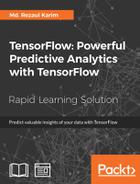In this lesson, we have discussed supervised learning from the theoretical and practical perspective. In particular, we have revisited the linear regression model for regression analysis. We have seen how to use regression for predicting continuous values. Later in this lesson, we have discussed some other supervised learning algorithms for predictive analytics. We have seen how to use logistic regression, SVM, and random forests for survival prediction on the Titanic dataset. Finally, we have seen a comparative analysis between these classifiers. We have also seen that random forest, which is based on decision trees ensembles, outperforms logistic regression and linear SVM models.
In Lesson 3, Clustering Your Data – Unsupervised Learning for Predictive Analytics, we will provide some practical examples of unsupervised learning. Particularly, the clustering technique using TensorFlow will be provided for neighborhood clustering and audio clustering from audio features.
More specifically, we will provide an exploratory analysis of the dataset then we will develop a cluster of the neighborhood using K-means, K-NN, and bisecting K-means with sufficient performance metrics such as cluster cost, accuracy, and so on. In the second part of the lesson, we will see how to do audio feature clustering. Finally, we will provide a comparative analysis of clustering algorithms.
